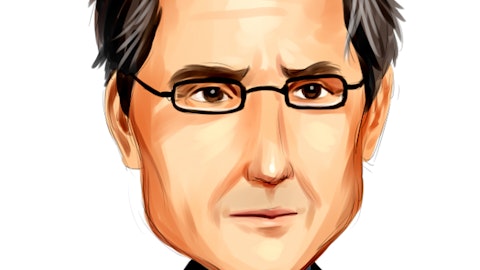Chris Gorman: Sure, Scott. Happy to address that. So if you take what we just reported of $136 million specifically on the line you asked about investment banking and debt placement fees, that would annualize at about 5.44. Conversely, if you took sort of the business and removed 2021 and said that’s an outlier, the traditional run rate is at least kind of $650 million. So, I think we have been conservative, and that’s why we, when we gave guidance, we said non-interest income up 5 plus and then we put the qualifier upside of capital markets activity normalizes. We don’t see it really normalizing until the back half of the year. However, it’s an interesting phenomenon when the 10-year went above 5% and then came back down. As you can imagine, people started to transact.
And so, we’re seeing the beginning of it now, but yes, it’s a conservative number. The other thing that’s in that fee number is, you saw that we had a step down with respect to our derivatives and hedging income. A lot of that is tied to the balance sheet and as we go through 2024 and we get back to growing the balance sheet after going through our exercise on RWAs, you’ll see that come back as well.
Operator: Next, we go to John Pancari with Evercore.
John Pancari: First, congratulations, Vern. Best of luck. You’re a legend. And Brian, welcome. Looking forward to working with you again. Question on the, a little bit more on the NII dynamics. Wanted to get your thoughts on, if we do see the cuts materialize as you had baked in your expectations, what type of deposit beta you expect is achievable on the initial cuts? And how would you think about accumulative on the way down? And what is factored into your net interest income outlook in terms of that beta?
Chris Gorman: So I’ll start with that and then I’m going to flip it over to Clark. A couple of things to keep in mind. We have a big commercial franchise. And so 40% of our deposits, $145 billion are commercial and of those about two-third are either indexed or index like. Now on the other side of the equation, we’ve been pretty conservative in assuming that as the first cuts, particularly if they aren’t steep cuts, that we’ll continue to get drift up on the consumer side. Also, we’ve forecasted just a bit of continued transition from interest-bearing to noninterest-bearing, but we think we’ve sort of bottomed out there. Clark, what would you add to that?
Clark Khayat: Yes. So maybe broadly, John, on the NII guide, we would expect some drift up, particularly in the first quarter on deposit pricing just as rates stay high. As Chris said, when the cuts come, I think a good way to think about that commercial book, as we’ve talked about the index nature of it, as Chris just referenced, is sort of kind of an almost automatic mid-teens beta on a cut, because of that how that index pulls through. So the question really is going to be what happens to the consumer book and how quickly can we move that. I think a 25 basis point cut with a kind of long waiting period. Does it provide a lot of opportunity to reduce? If we start to see bigger cuts or cut sooner or more rapid cuts that allows us to deploy those price reductions into the book.
So right now, as I’ve said, we’re really looking at kind of our view is more like the four cuts starting in the middle of the year. We think we’ll probably have some stabilization, maybe a little a bit of consumer drift through that time period. And then we’ll start to proactively move rates down. But given the timeframe and 2024, hard to say exactly what the beta will be on the way down for the year. But it’s really going to pick up in ’25. We’ll see some benefit in ’24, but on the consumer book, it’s just going to lag a little bit. And candidly, that’s just going to be as much a competitive function of competitive environment as anything else. But we are taking some actions in the consumer book today to prepare for cuts. We’re not cutting rates, but preparing our franchise to be ready for that.
And I think we’ll be very proactive when that opportunity shows up.
Chris Gorman: And frankly, all markets are not the same. We’re out there experimenting with a few things as we speak.
John Pancari: Got it. Okay. And then separately, on the credit front, can you give us a little bit more color on the 25% increase in nonperformers in the quarter? And maybe a little more color on the criticized asset increase? And I know your commercial real estate NPL ratio now is 6.9%. What was that last quarter? Was that the biggest increase in the nonperformers?
Clark Khayat: Yes, I’ll come back to you on the increase from third quarter. I don’t have that right in front of me. But on your other points, the NPA uptick really is a small list of identified credits, most of which we feel very good about the loss content. So it is a pickup in the ratio, but we don’t think that’s a loss driver. On criticized, look, that is a function of continued higher rates, putting some stress on what I’d call kind of the first order rating variable around debt service coverage. So that does drive rating migration in our book. That rating migration does pull through to criticized and classified. But when you get underneath that metric and you look at things like clients’ willingness to build the interest reserve and the value of the collateral given, we tend to underwrite at 60% or lower CLTVs out of the gate, we just don’t see a lot of loss content there.
John Pancari: And just one clarification, so it was primarily C&I related in terms of the NPA increase or CRE?
Chris Gorman: There were three specific credits, one of which was real estate.
Operator: Next, we go to the line of Manan Gosalia with Morgan Stanley.
Manan Gosalia : I wanted to extend my best to Vern as well. And I just wanted to say we really appreciate all your help over there. So a big thank you. And then on my question, I think you said you still expect some modest RWA reduction in the first half of 2024. Is that all coming from the loan book? And as we think about the long end of the curve staying here or even moving lower, you should have a lot more clarity on accreting that AOCI back over time. So, what would you need to start leaning into loan growth a little or deploying capital elsewhere?





